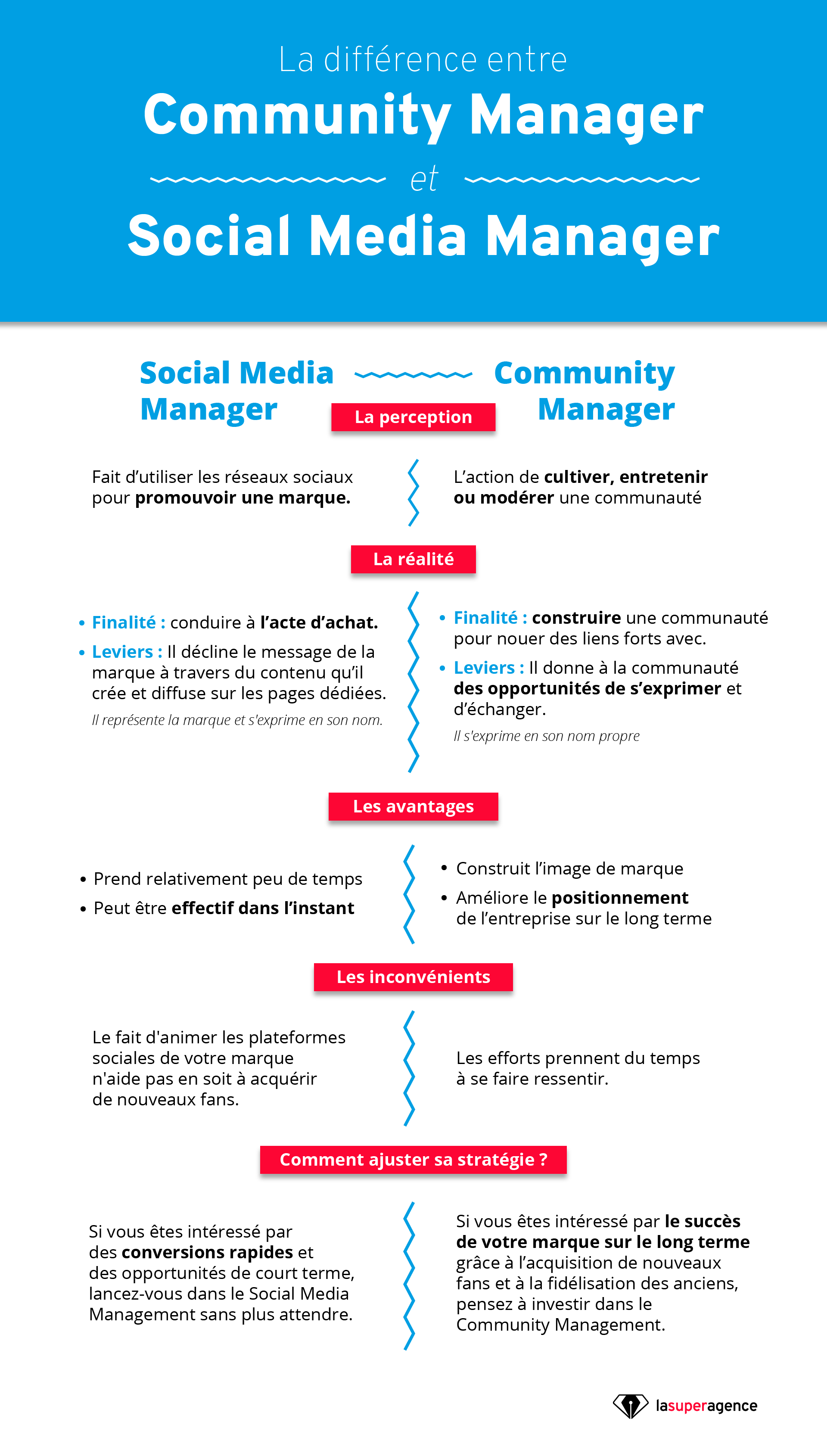Not long ago, French companies were questioning the value of their presence on social networks. Today, they have understood the full potential of these platforms and are launching more and more ambitious marketing campaigns there.
Still, they need effective resources to achieve their goal. So, more Community Management or Social Media Management? (or both?)
Acquiring leads through social networks is part of a social media strategy or more broadly Inbound Marketing.
To describe this presence on social networks, we find often the function of " Community Manager".
Or, the Community Manager comes downstream from the Social Media Manager.
Community Manager and Social Media Manager are indeed functions with quite different tasks and purposes.
The two practices can be confused in some cases but it remains useful to understand the differences of these two jobs.

The Perception
It's easy to see how the terms have become interchangeable over time.
The contours of social media management can be quite fuzzy and its definition shifting. In a nutshell, it's the act of using social media to promote a brand.
According to this description, having a Facebook page falls under the tasks of the "Social Media Manager".
Summarizing again, " Community Management " refers to the action of creating, maintaining or moderating a community.
If you publish content on social media with the intention of building a community, then that makes you a Community Manager.
The Reality
At the origin of Social Media Marketing, we find the same purpose as for traditional marketing: to lead to the act of purchase. For this, the levers are brand image building and visibility.
Marketing applied to social networks therefore involves finding fans (or followers) by drawing them to the brand's page with interesting content and share buttons and encouraging them to like the page.
Potential customers receive news about the brand that will improve the perception of the brand and eventually lead to purchase.
The Social Media Manager is in charge of declining the brand's message on the different media (Facebook, Twitter or LinkedIn). He creates content for this purpose, which he distributes on the dedicated pages.
He thus represents the brand on social networks and speaks on its behalf.

Source: Flickr @ausnahmezustand
In contrast, Community Management has a priori little to do with Marketing. The Community Manager is responsible for building (or modifying) a community with the objective of building strong ties with it.
The Community Manager creates their own online Persona, speaking on different platforms, on their behalf, in order to find new fans and be a brand ambassador.
In general, the Community Manager is mainly interested in those who have never heard of the brand.
He will try to attract new fans (or followers) and works on the interactivity of the community by giving them opportunities to express themselves and exchange with each other.
Where the two functions come together is in social network animation which generally leads to the community growing and being more active.
The larger and more participatory the community, the more fans will turn into potential customers through marketing efforts.
The Social Media Manager
The Benefits:
Social network marketing through page animation takes relatively little time and can be effective in the moment (there is no delay in getting the message out as there is with so-called traditional media).
Social network business page animation generates positive results immediately.
By tracking metrics with the analytics tools available on each platform, you can monitor traffic and engagement in near real time.
The Social Media Manager closely monitors the results for each post and adapts the message as to get better engagement.
The downside:
Hosting your brand's social platforms doesn't in itself help acquire new fans.
The Community Manager
The Benefits:
Community management is essential to maintain connections with an audience that has already purchased your products or might be tempted. Simply hosting social media doesn't really make it easy to sign up new fans.
It's more about community management that will make the difference by cultivating connections and thus improving brand reputation.
The Community Manager focuses on building the brand image instead of just thinking about bringing new sales. In this way, he or she helps with better positioning of the company in the long run.
The Community Manager is not only the voice of the company to the community, he is also the voice of the community to the company.
The downside:
The Community Manager's efforts take time to be felt.
In fact, it's much more difficult to be able to measure a community's involvement and level of adherence to the brand than it is to track quantitative measures of results.

Source: Flickr @DylanPayne
The Brave New World
It can be said that the size of the company will largely determine the needs in this area. For a small to medium sized company, a Social Media Management effort is sufficient.
In many cases, the relationship with the community doesn't really need to be very deep or not intended to be developed over time (think commodities).
Inversely, a company that sells complex products - such as software - will be able to benefit from the work of a Community Manager who will also have the vocation to be educational about product options.
In other words, a B2B company will be able to benefit more from the services of a Community Manager than a B2C company that may be "content" with having a Social Media Manager.
How to adjust your strategy
If you're interested in quick conversions and short-term opportunities, get started on Social Media Management without further delay.
By increasing the volume of posts and distilling Call-To-Action, you'll see the effects of your increased social media presence on your sales within a few months.
If, on the other hand, you are more interested in the long-term success of your brand through acquiring new fans and retaining old ones, consider investing in Community Management.
Community Management does not dispense with Social Media Management. For the community to live, there must first be regular news and some topicality to keep the pages alive.
On the other hand, Social Media Management can do without Community Management, especially when the fan base is not large and the exchanges are few.










